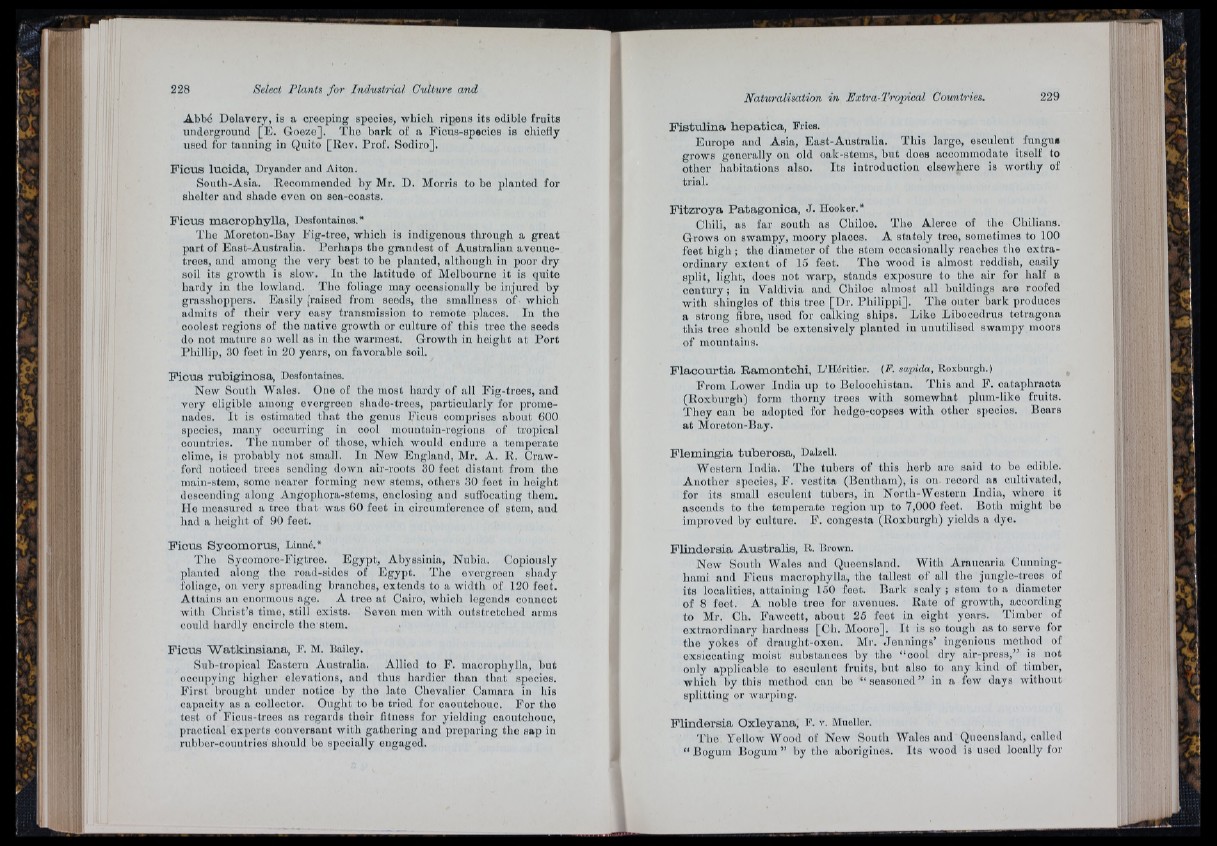
'■Y!
i l í
Naturalisation in Extra-Tropical Countries. 229
Abbe Dolavory, is a croopiiig species, wliioh ripens its edible frnits
niulorground [1Í. (loozo]. The liark of a Ficus-spacios is oliioily
nsod for (aiming in Quito [Uov. Prof. Sodiro].
Ficus lucida, Dryaiulor aud Aiton.
South-Asia. Rocommeiuiod liy Mr. D. Morris to bo piautod for
siioltor and siiado even ou soa-coasts.
Ficus macrophylla, Dosfontainos.*
'I’lio Moroton-liay Pig-troe, wliich is indigenous through a groat
part of Kast-Austraiia. Perhaps tlio grandest of Australian avoimo-
trocs, and among tlie very liost to bo jilautod, altliougii in jioor dry
soil its growtli is slow, in tlio latitudo of Molbourno it is (|uito
liardy in tlio lowland. '.I'lio foliage may ocoasioiially bo iiijurcil by
gra.sslioppors. Easily [raised from seeds, tlie smallness of wlucli
iidmiis of (lioir vory easy trauamission to remoto places. Iu tbo
coolost regions of tlio nativo growtli or culture of tliis treo tlio seeds
do not inatnro so well as in tlio wannest. Growth in lioigbt a t Po rt
Phillip, DO foot in 20 years, on favorable soil.
Ficus rubiginosa, Dosfonlninos.
Now South Walos. One of (lie most liardy of all Fig-troes, and
very eligible among overgroeii sliado-troos, |iarticnlarly fnr proiiie-
iiadoH. It is estimated tliat tbo gonns Piens conijirisos abont (iOO
species, many occurring iu cool nionntaln-rogions of trojiical
countries. Tbo nimibor of tlioso, wliich would ondnro a tomperato
clinio, is probably not small, in Now England, Mr. A. ii. Crawford
noticed treOB sending down air-rools DO foot distant from tbo
niain-Hteiii, some noaror foniiing now steins, olbers DO foot in lioigbt
dosoendiiig along Aiigoiiliora-stoiiis, onclosing and snffocating tbein.
Ho moaaurod a tree that was (iO foot in circnmroronco of stem, and
had a lieiglit of 90 foot.
Pious Sycomorus, Jnnnó.*
Tbo Sycoinoro-IfigI.reo. Egyjit, Aliyssinia, Nnbia. Copiously
planted along tbo road-sides of Egypt. I'lie ovovgrocn sliady
foliage, on vory sjiveuding brancbos, extends to a width of 120 foot.
Al.lains an enormous ago. A tree a t Cairo, wliicli legoiid« connect
with Cbriat’s time, still exists. Sovon men with outstrotebod arms
could luu'dly oneirclo the stem.
Ficus Watkinsiana, P M. liailoy.
Snb-lropical Eastern Australia. Allied to F. mneropbylla, but
oceu|iying bigbor olcvatioiiB, and tlms bardior tban that spocios.
F irst bronglit niider notice by the late Clievalior Camara in bis
capacity as a collector. Ought to be tried for oaontclioiic. For tho
tost of Ficns-ti'oos as rogarda tliolr litnoss for yielding caoutcliouc,
practical exports converaaiit with gatlioring and propariiig tlio sap in
rnblicr-cnimtrios sbould iio specially ongagod.
i
Fistulina hepática. Frica.
Enropo and Asia, East-Australia. This largo, escnlont fuiigin
grows gouorally on old oak-sl;em.s, but docs accommodato itself to
otbor lialiitatioiis also. Its introduction olsewlioro is worthy of
trial.
P itz r o y a Pata g ónica , I. Hooker.*
Cliili, as far sontli as Cliiloo. The Aloroo of tbo Chilians.
Grows on awampy, moory places. A stately treo, somotimoa to 100
foot liigli; tho dinniotor of tbe atom occasionally roacboa tbo ex tra ordinary
oxtont of 15 foot. Tbo wood is almost reddish, easily
split, light, does not war]i, stands oxposiiro to the air for half a
contnry; in Valdivia and Cliiloo almost all Imildhigs are roofed
with sbinglos of tbis troo [Dr. Philippi]. Tbe outer bark prodiicos
a strong fibre, nsod for caikiiig ships. Liko Libocodrus totrngomi
this troo sluinld bo oxtonsLvoly planted iu niiulilised swampy moors
of monntains.
Placourtia Bamontchi, L’lKritier. (P. sapida, KoxburgU.)
From Iiower India np to lioloocliistan. Tbis and F. cataphvaota
(Ko.xbnrgb) form thorny troos with somowhat plnm-liko frnits.
They can bo ado|itod for liedgo-eopsos with other spocios. Hoars
a t Morotoii-Iiay.
Plemingia tuberosa, Dalzell.
Western India. Tho tubers of this liorb are said to bo ediblo.
Aiiotbor sjiecios, F. vostita. (llontliam), is on record as cnltivatoil,
for its small osciilont tnlicrs, in Nortli-Wostorn India, wlioro it
ascends to tlio tomporate region up to 7,000 foot. Both miglit be
improved by culturo. I'\ coiigosta (Roxburgh) yields a dye.
Plindersia Australis, K. Brown.
New SonI.b Wales and (¿necusland. With Araucaria Cnimnig-
liami and Ficus imicropbylla, tho tallest of all tbo jnnglo-troos of
its localitios, attaining 150 foot. Bark scaly ; stom to a dni,motor
of 8 feet. A noblo troo for avomies. Rate of growth, aecording
to Mr. Cb. Fawcott, about 25 foot iu eight yoars. Timber of
oxtraordinary liariliuiss [Cb. Moore]. It is so toiigb as to servo for
tlio yokes of drangbt-oxon. Mr. Jonuings’ ingonions niotbod oi
oXHiocatiiig moist snbstaiicos liy tbe “ cool dry air-press,” is not
only apiilicatilo l.o escnlent frnits, lint also to any kind of timber,
wliicli liy tliis niotliod can lie “ seasoned” in a few days witliont
splitting or warping.
Plindersia Oxleyana, k. v. Mnollor.
Tlie Yellow Wood of New Soutli Wales aud (¿iioonHlaiul, callod
“ Bnguiii Bogum ” liy tlio aborigines, it s wood is used locally for